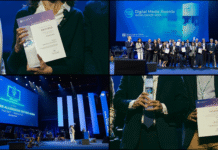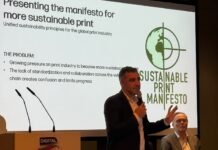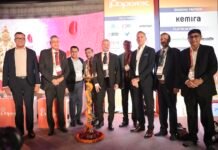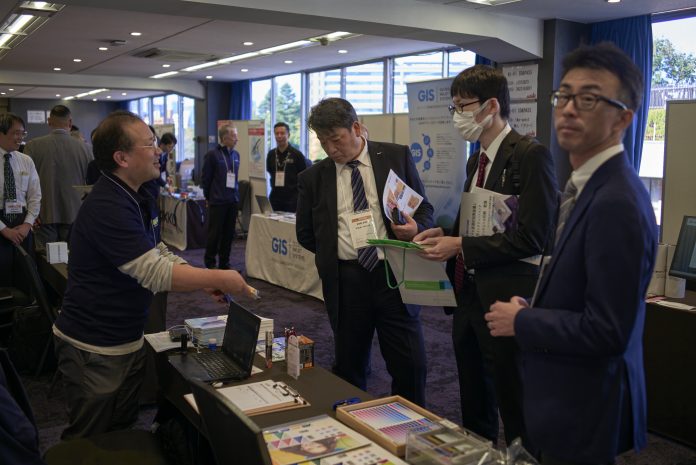
Recently I returned to Japan to cover the second outing of the Japan Inkjet Technology Fair, having written about last year’s inaugural event. It’s a small, tightly focussed show that offers a unique perspective on the Japanese inkjet industry, as well as a chance to catch up with old friends.
The JITF was set up by Akiyoshi Ohno of Ohno Consulting. As the former head of Konica Minolta’s inkjet business unit, he’s extremely well connected throughout the Japanese inkjet industry and beyond. And in the interests of full disclosure I should point out that he also regularly publishes Japanese translations of many of the stories that I write here on Printing and Manufacturing Journal.
What makes the JITF such a unique event is that its main focus is not so much on products, but on people and particularly the visitors themselves with Ohno’s main goal being to build the same sense of community amongst the inkjet professionals in Japan that exists in other advanced nations. In places like Europe and America people tend to flit between companies and even between industries as they seek to build up a rounded career profile. But many Japanese people might spend most of their careers with a single company, which makes for a more insular approach.
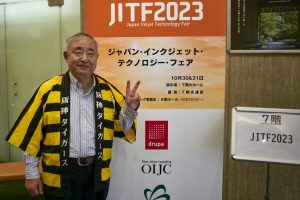
Ohno was inspired by other events in these countries, such as the upcoming IPI conference in Germany this month, which allows people from across the different parts of the inkjet world to come together. “But in Japan there’s no such organisation and no community,“ he says, adding, “We all know each other but we don’t see the whole picture.”
He continues, “I wanted a combination of a table top exhibition, presentations and networking parts to bring people together, to form a community. That’s my first goal, which already exists in Europe but not in Japan.”
A key part of this is the networking event at the end of the first day which allows everyone to get together and chat over a drink and some food. Ohno explains, “My belief is that if 250 people are together in one room with beer and food and talking together then there should be a certain chemical reaction started automatically. And after two years I can say the networking party is successful.”
This year’s show returned to the same venue in Ichigaya as last year but on a different floor which allowed for slightly more space for everyone to mingle. There were roughly a thousand visitors over two days, which is 20% up on the first show. Otherwise the event followed the same format with one large room with 40 table top booths plus three separate conference rooms for presentations. These presentations were mostly in Japanese for obvious reasons but there were several in English that were very well attended.
Ohno says that this was a deliberate strategy as he did not want the JITF to develop as a domestic event – “I want to make it as much as possible international. People hesitate to speak English but to listen to an English lecture is much easier for them. And we can have translators but English is the standard in the world.”
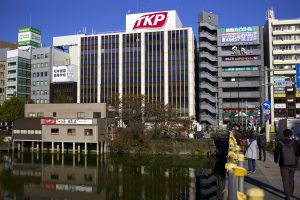
Amongst the English presentations, Richard Darling, business development manager for GIS, argued that technology developers should pay more attention to the costs of the technology they are developing, rather than just the capabilities and to ask what level of technology is appropriate for any given application. He noted, “I know of corrugated printers who think that 1200 dpi is essential but I don’t think any customers think that is a good idea.”
He added, “Not enough customers are buying industrial inkjet printers because it’s not all about faster; it’s about reliability and price points.” He suggested that buying in components rather than developing everything in-house could help vendors lower their prices. He also pointed out that taking advantage of specialist expertise might also lead to printer vendors using better components, noting that 40-50% of all head drive systems don’t support the highest firing frequency or the best optimizations.
GIS is now part of the Nano Dimension group, which also includes the Deep Cube AI technology. According to Darling, this has a lot of potential uses, “If you make readings and feed that into the Deep Cube then the system can learn what has to be done to improve the uptime.”
He continued, “Packaging printing has to be just good enough. It doesn’t have to be better. Time costs money so time to market is important. If you can launch something early then you can start to make money earlier. It’s all about money.”
To this end he argues that it’s better to find partners to develop with, saying, “I think there’s some need for standard products. Standardization improves manufacturing efficiency. But there’s also some need for specialization. Not everything in industrial inkjet needs to be bespoke.”
He concludes by saying that industrial inkjet is still a young business but that the office printing companies that fund it are getting older, adding, “We should take care of those parents.”

In another presentation, Terry O’Keefe, Fujifilm’s product manager for its Samba print heads, gave an overview of the current Samba head and teased some indication of the next generation.
He pointed out some of the challenges, noting, “We have to be able to reach the image quality target and to be able to do it with the fluids that will reach the applications we are targeting. We have to be able to jet the drops accurately on the substrate and they have to land where they are supposed to go to get good edge definition.”
He continued, “We have to be able to produce the image quality at the speed. And we have to be able to maintain the ink, and we have to be able to recover fast if we de-prime, and recirculation helps with that.”
He describes the basic approach behind the Samba heads of using a small native drop size with a double pulse controlled through the waveform to achieve higher coverage. He explained, “We use the waveform to optimize it so that all the drops land at about the same time to produce the best quality image we can.” He continued, “And then a third pulse for compensation, if you have a problem.”
There are two types of Samba head. The G3L has a 2.4pl (pico-liters) native drop and can print at around 120 meters per minute. It’s mainly targeted at higher image quality applications such as labels and flexible packaging. Then there’s the G5L, which has a 3.5pl drop, which can run at up to 150 meters per minute. This is mainly aimed at applications such as textiles and corrugated packaging. It’s worth noting that doubling up the print bars could allow for speeds of up to 300 meters per minute.
He finished up by saying that the next variant of the Samba head technology will be focussed on more productivity, adding that there’s no demand for more than 1200 dpi resolution. He said, “It’s all about reliability, speed and easier integration.”
A question from the floor asked about the feasibility of having smaller drop sizes down to 1pl for the printed electronics market. O’Keefe noted that this is a relatively small market, adding, “It’s not easy to jet a 1pl ink droplet on target.
Another question from the audience asked about additive manufacturing but O’Keefe replied, “My opinion is that the people in the additive manufacturing space are less interested in the print heads than in the graphics space, adding, “I don’t think that market needs anything below 10pl.”

The show also featured several other printhead manufacturers. Riso has developed a new inkjet printhead that’s designed to print text and graphics direct to corrugated boards and boxes. The company brought along some samples to demonstrate its capability. The C1 printhead is still at a prototype stage but the samples did look very promising as a cost-effective method for printing to corrugated boxes.
It can be used for monochrome printing at 600 x 600 dpi resolution. It will also support color applications, with a choice of two channels at 300 x 600 dpi or four colors at 300 x 300 dpi resolution. There are up to 18 different variants, which should ensure a good fit with most existing packaging lines. The maximum print width ranges from 100mm to 310mm, depending on the variant. It has a maximum print length of 2 meters. It can print at up to 30 meters per minute in its standard mode, which drops to 18 meters per minute in the Fine print mode.

The C1 system consists of two parts. The main unit contains all the electronics and ink tanks, but the heads themselves are in a separate module. This gives maximum flexibility for retrofitting the system to a packaging line as the head unit can be configured above the line to print downwards onto corrugated boards or sideways to print vertically onto boxes. The head unit also includes an ink recirculation system to improve reliability, which is essential in a packaging line where the operators might not have much print expertise.
It’s been developed from Riso’s existing inkjet technology, which is fairly unique in that it uses a plant oil-based pigment ink. This is a fairly sustainable approach that doesn’t use water and so there’s no drying required. Instead the ink is absorbed into the substrate fibers with the excess evaporating off. The ink is waterproof so it doesn’t matter if the boxes get caught out in the rain. There’s no white ink yet but Riso is working on this.
This same system is already used in a number of office printers and the light production Valezus T-series inkjet printers. However the new head has much higher pressure which allows it to print horizontally.
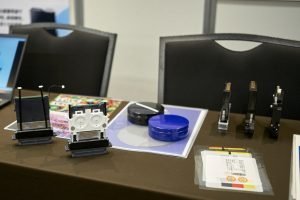
Konica Minolta showed off several of its printheads, including the 800 series heads that have come from its acquisition of Panasonic’s head business a few years back. Konica Minolta has found that by tightly controlling the shape of the nozzle it can maintain accurate drop placement over longer throw distances and that this also allows the heads to be used for horizontal jetting.
The KM800 series heads use a circular nozzle but the edges of each nozzle are carefully chamfered, rather than drilling straight through, which creates a V-shaped angled edge at the nozzle exit. Toshio Tsuzuku, senior manager with Konica Minolta’s inkjet components sales team, says that this angle is very critical in determining the force at which the drop leaves the nozzle. The nozzle plate itself is made of stainless steel for durability.
Tsuzuku told me, “Panasonic promoted the head for textile applications so when we promote the head we are looking for other applications like corrugated.”
Konica Minolta also showed off its KM1024 analogue series. Tsuzuku explained, “The advantage of the analogue waveform is that you can change the waveform very easily. The digital waveform is not so flexible. So we can jet large drops at the same jetting speed. The frequency is not dropped.” This is mainly suitable for signage and for corrugated printing applications.
Tsuzuku says that Konica Minolta is also investigating whether or not it can improve the throw distance to its other heads by tweaking the angle around the nozzle in the same way, adding, “And when we analyzed the 1024a heads we found that it can also do a longer throw distance.”

Toshiba Tec showed off its printheads, with Akifumi Seko, a specialist for Toshiba’s sales department, noting of the event, “It’s a good chance to meet ink manufacturers. We don’t usually have an opportunity to speak to other head manufacturers so this is a chance to talk with them as well.”
The Toshiba heads all use the shear wall drop-on-demand piezo technology that the company originally licensed from Xaar. Seko explained that the company divides its lines into two types: the CE4 series, which do not have recirculation and are mainly aimed at graphics applications such as wide format; and the CF1 and CF3 lines that do have recirculation and are suitable for more industrial applications. However they only take UV and oil-based inks (as well as eco-solvent for the CE4 heads) and not aqueous inks, which is a weakness in Xaar’s older technology.
The CF1 heads produce 300 npi resolution while the CF3 heads can produce 600 npi with one channel or two channels of 300 npi each. Seko points out that resolution requirements depend on the application and the balance between print quality and price that the OEM is trying to reach.
Toshiba Tec also sells a useful accessory, the CC1, which is essentially a box with the pumps and everything necessary to support recirculation; users just need to plug in the printhead. This is useful for industrial applications such as direct to shape and printed electronics.
Epson also showed off its range of printheads, including the relatively recent D-series. This is mainly designed for single pass packaging and labels as well as for textile printing such as DtF. I’ve already covered Epson’s range in some detail in previous stories.
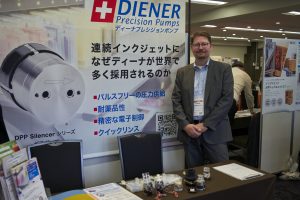
There were two separate companies showing pumps suitable for inkjet systems. KNF uses a diaphragm design while the German company Diener uses gears. Dr Ralf Mayer of San Ten Consulting, who is working with Diener in Japan, explains, “These pumps are for continuous inkjet where you have higher pressure.” He says that one advantage of using gears is that customers can specify the materials used in the gears and the O-rings according to the fluids they want to pump. However, the disadvantage is that the gear pumps can only be used with aqueous and solvent inks but are not suitable for UV inks as these inks tend to cure in the pump and clog up the system.

Microjet showed off a drop watching device called the LaboJet 600. This has two cameras as Maeta Norihiro of Microjet explains, “One camera is for watching the droplet form. But there is also a top view camera to watch the drop at the same time. The cameras can check the wetting and drying process by watching it directly.” This device is mainly sold to companies developing new materials and new inks. For now it’s only available in Japan but MicroJet is hoping to set up sales channels in the US and Europe in the near future.”
The event also featured quite a few ink manufacturing companies, which I will cover in the next part of this story later this week. In the meantime you can find further details from ohno-inkjet.com.
First published in the Printing and Manufacturing Journal on 20th November 2023. Reprinted by permission – www.nessancleary.co.uk





